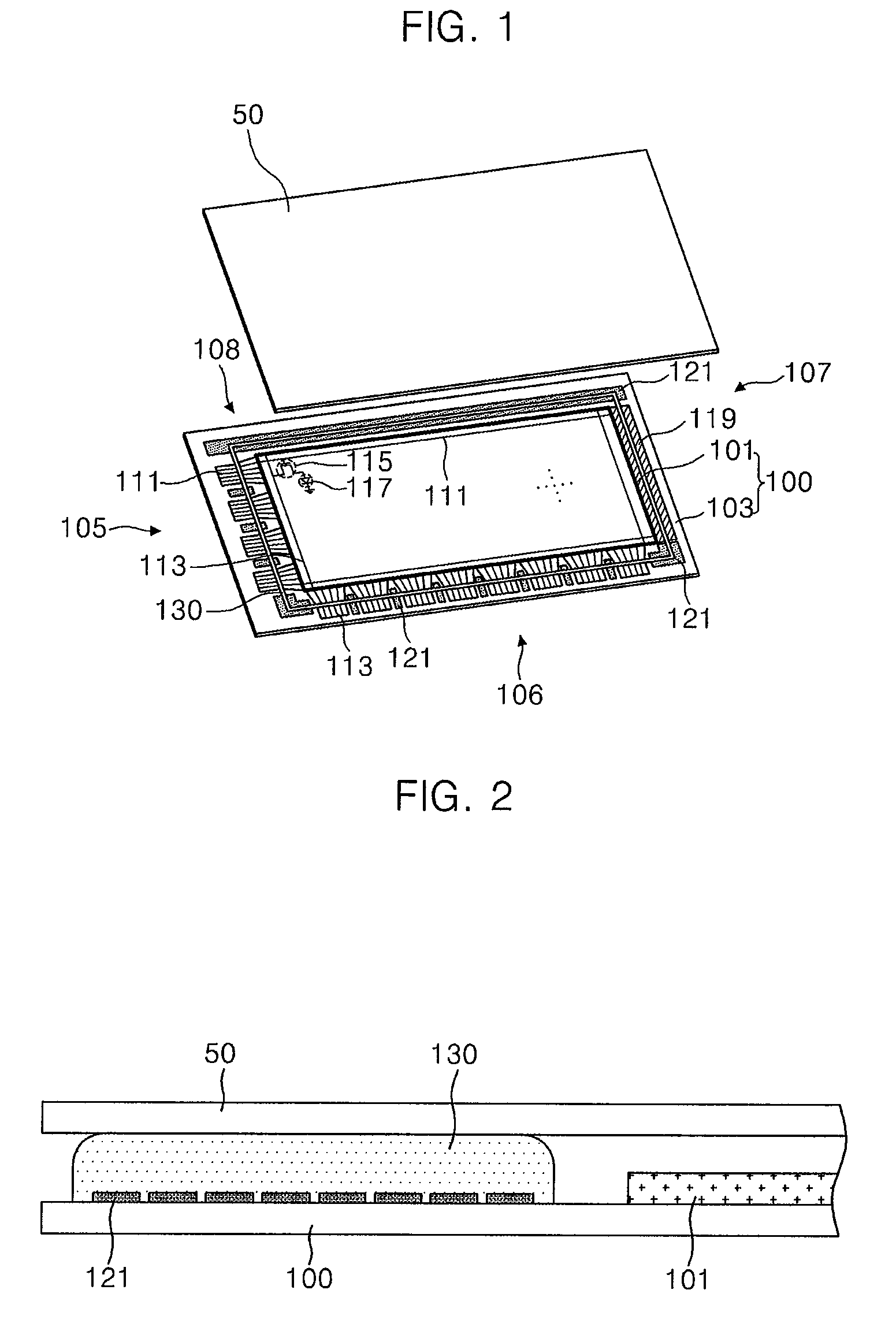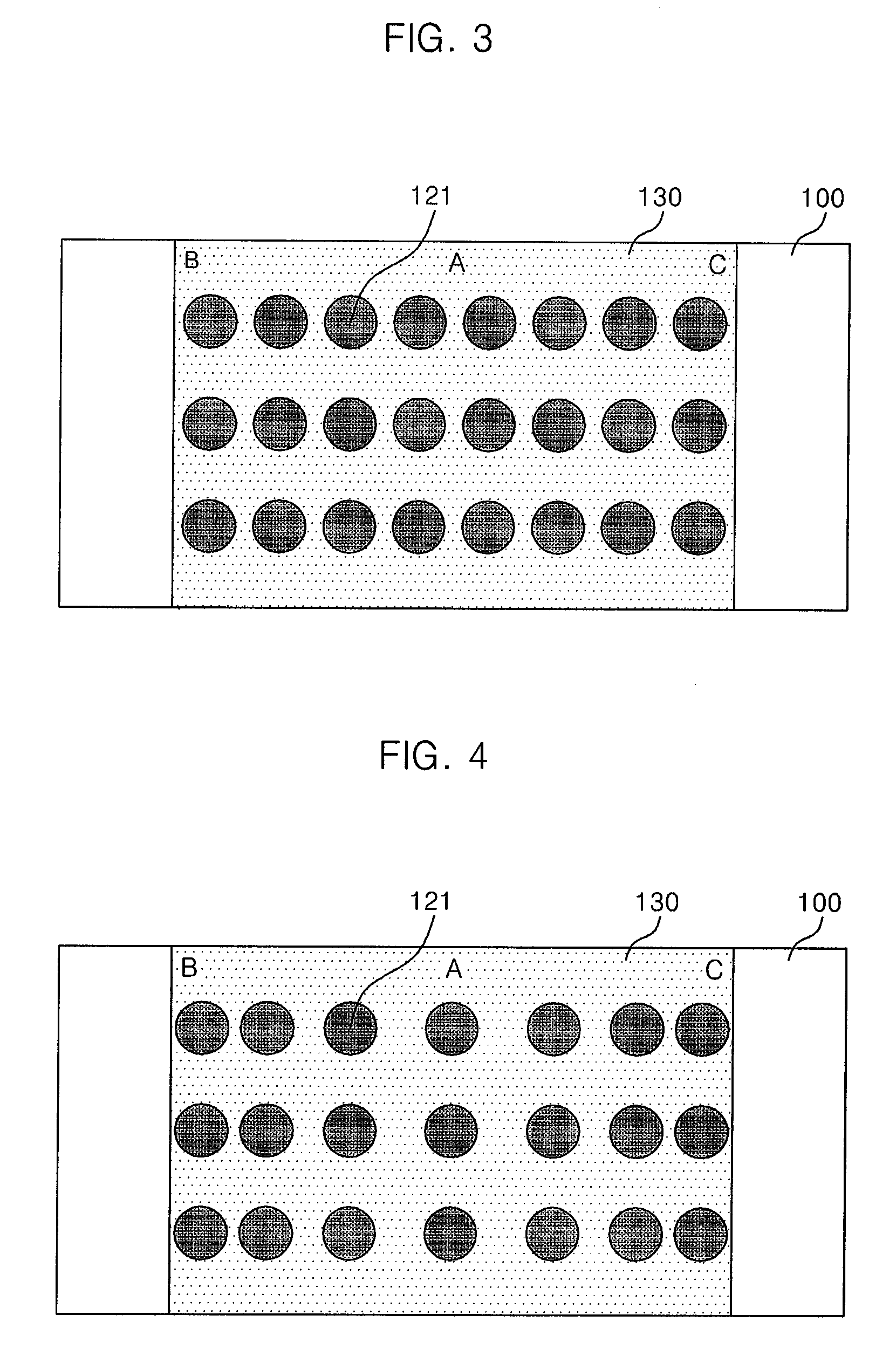Organic light emitting device
- Summary
- Abstract
- Description
- Claims
- Application Information
AI Technical Summary
Benefits of technology
Problems solved by technology
Method used
Image
Examples
first embodiment
[0059]Referring to FIGS. 2 and 3, an auxiliary metallic layer 121 of an OLED in accordance with the present invention is formed as a dot shape, and is disposed at constant intervals between the edges of frit 130.
[0060]The auxiliary metallic layer 121 is formed on a second substrate 100 to be overlapped by the frit 130. The auxiliary metallic layer 121 may be formed from a plurality of metallic groups, which is formed as one of a circle shape, an elliptical shape and a polygonal shape.
[0061]The auxiliary metallic layer 121 uniformly distributes energies provided to a center A and both sides B and C of the frit 130 when a laser is irradiated on the frit 130.
[0062]A width of a line of the frit 130 is formed to be less than a width of the laser beam which will be used to heat the frit 130. An amount of the laser energy provided to the center A of the frit 130 is greater than the amount of the laser energy provided to sides B and C is low. The frit 130 has difference energy distribution ...
second embodiment
[0067]FIG. 4 is a plan view illustrating a peripheral portion of an OLED in accordance with the present invention.
[0068]Referring to FIG. 4, an auxiliary metallic layer 121 in accordance with the second embodiment of the present invention is formed as a dot shape, and is disposed closer to both sides B and C than to center A of the frit 130. The auxiliary metallic layer 121 may be formed as one of a circle shape, an elliptical shape and a polygonal shape.
[0069]The auxiliary metallic layer 121 uniformly distributes energies provided to the center A and both sides B and C of the frit 130 when a laser is irradiated on the frit 130. The auxiliary metallic layer 121 is disposed denser at both sides B and C of the frit 130 than at the center A of the frit 130, so that the energy, which distributes highly at the center A of the frit 130 and lowly at the sides B and C, automatically becomes uniform by the auxiliary metallic layer 121.
third embodiment
[0070]FIG. 5 is a plan view illustrating a peripheral portion of an OLED in accordance with the present invention.
[0071]Referring to FIG. 5, an auxiliary metallic layer 121 in accordance with the third embodiment of the present invention is formed as a dot shape, and is disposed densely only at both sides B and C of the frit 130. The auxiliary metallic layer 121 may be formed as one of a circle shape, an elliptical shape and a polygonal shape.
[0072]The auxiliary metallic layer 121 highly distributes energy at sides B and C, at which the energy is distributed relatively lowly compared to the center A of the frit 130. Thus, the energy distribution at the center A and both sides B and C of the frit 130 becomes uniform.
[0073]Moreover, the auxiliary metallic layer 121 is not formed at the center A of the frit 130, so that adhesion between the second substrate 100 and the frit 130 is improved.
PUM
 Login to View More
Login to View More Abstract
Description
Claims
Application Information
 Login to View More
Login to View More - R&D
- Intellectual Property
- Life Sciences
- Materials
- Tech Scout
- Unparalleled Data Quality
- Higher Quality Content
- 60% Fewer Hallucinations
Browse by: Latest US Patents, China's latest patents, Technical Efficacy Thesaurus, Application Domain, Technology Topic, Popular Technical Reports.
© 2025 PatSnap. All rights reserved.Legal|Privacy policy|Modern Slavery Act Transparency Statement|Sitemap|About US| Contact US: help@patsnap.com



